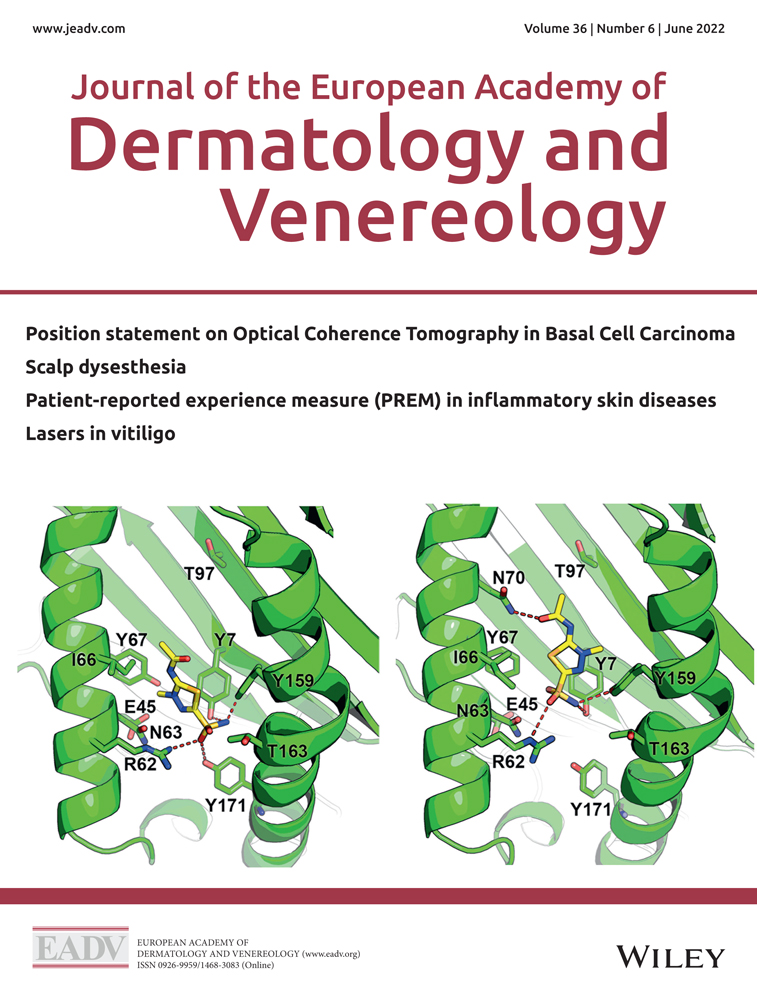Basic skin therapy effects on skin inflammation and microbiome composition in patients with atopic dermatitis after challenges with grass pollen
Corresponding Author
A. Heratizadeh
Division of Immunodermatology and Allergy Research, Department of Dermatology and Allergy, Hannover Medical School, Hannover, Germany
Equal contributions.*Correspondence: A. Heratizadeh. E-mail: [email protected]
Search for more papers by this authorL.M. Roesner
Division of Immunodermatology and Allergy Research, Department of Dermatology and Allergy, Hannover Medical School, Hannover, Germany
Equal contributions.Search for more papers by this authorS. Traidl
Division of Immunodermatology and Allergy Research, Department of Dermatology and Allergy, Hannover Medical School, Hannover, Germany
Search for more papers by this authorL. Moitinho-Silva
Department of Dermatology and Allergy, University Hospital Schleswig-Holstein, Kiel, Germany
Institute of Clinical Molecular Biology, Kiel University, Kiel, Germany
Search for more papers by this authorB. Ellinghusen
Fraunhofer Institute of Toxicology and Experimental Medicine, Hannover, Germany
Search for more papers by this authorE. Rodriguez
Department of Dermatology and Allergy, University Hospital Schleswig-Holstein, Kiel, Germany
Search for more papers by this authorI. Harder
Department of Dermatology and Allergy, University Hospital Schleswig-Holstein, Kiel, Germany
Search for more papers by this authorM. Sapak
Division of Immunodermatology and Allergy Research, Department of Dermatology and Allergy, Hannover Medical School, Hannover, Germany
Institute of Immunology, Faculty of Medicine, Comenius University in Bratislava, Bratislava, Slovakia
Search for more papers by this authorS. Weidinger
Department of Dermatology and Allergy, University Hospital Schleswig-Holstein, Kiel, Germany
Search for more papers by this authorP. Badorrek
Fraunhofer Institute of Toxicology and Experimental Medicine, Hannover, Germany
Search for more papers by this authorJ.M. Hohlfeld
Fraunhofer Institute of Toxicology and Experimental Medicine, Hannover, Germany
Department of Respiratory Medicine, Hannover Medical School, Hannover, Germany
Biomedical Research in End-Stage and Obstructive Lung Disease (BREATH), German Center for Lung Research (DZL), Giessen, Germany
Equal contributions.Search for more papers by this authorT. Werfel
Division of Immunodermatology and Allergy Research, Department of Dermatology and Allergy, Hannover Medical School, Hannover, Germany
Equal contributions.Search for more papers by this authorCorresponding Author
A. Heratizadeh
Division of Immunodermatology and Allergy Research, Department of Dermatology and Allergy, Hannover Medical School, Hannover, Germany
Equal contributions.*Correspondence: A. Heratizadeh. E-mail: [email protected]
Search for more papers by this authorL.M. Roesner
Division of Immunodermatology and Allergy Research, Department of Dermatology and Allergy, Hannover Medical School, Hannover, Germany
Equal contributions.Search for more papers by this authorS. Traidl
Division of Immunodermatology and Allergy Research, Department of Dermatology and Allergy, Hannover Medical School, Hannover, Germany
Search for more papers by this authorL. Moitinho-Silva
Department of Dermatology and Allergy, University Hospital Schleswig-Holstein, Kiel, Germany
Institute of Clinical Molecular Biology, Kiel University, Kiel, Germany
Search for more papers by this authorB. Ellinghusen
Fraunhofer Institute of Toxicology and Experimental Medicine, Hannover, Germany
Search for more papers by this authorE. Rodriguez
Department of Dermatology and Allergy, University Hospital Schleswig-Holstein, Kiel, Germany
Search for more papers by this authorI. Harder
Department of Dermatology and Allergy, University Hospital Schleswig-Holstein, Kiel, Germany
Search for more papers by this authorM. Sapak
Division of Immunodermatology and Allergy Research, Department of Dermatology and Allergy, Hannover Medical School, Hannover, Germany
Institute of Immunology, Faculty of Medicine, Comenius University in Bratislava, Bratislava, Slovakia
Search for more papers by this authorS. Weidinger
Department of Dermatology and Allergy, University Hospital Schleswig-Holstein, Kiel, Germany
Search for more papers by this authorP. Badorrek
Fraunhofer Institute of Toxicology and Experimental Medicine, Hannover, Germany
Search for more papers by this authorJ.M. Hohlfeld
Fraunhofer Institute of Toxicology and Experimental Medicine, Hannover, Germany
Department of Respiratory Medicine, Hannover Medical School, Hannover, Germany
Biomedical Research in End-Stage and Obstructive Lung Disease (BREATH), German Center for Lung Research (DZL), Giessen, Germany
Equal contributions.Search for more papers by this authorT. Werfel
Division of Immunodermatology and Allergy Research, Department of Dermatology and Allergy, Hannover Medical School, Hannover, Germany
Equal contributions.Search for more papers by this author
References
- 1Werfel T, Heratizadeh A, Niebuhr M et al. Exacerbation of atopic dermatitis on grass pollen exposure in an environmental challenge chamber. J Allergy Clin Immunol 2015; 136: 96–103 e9.
- 2Angelova-Fischer I, Neufang G, Jung K et al. A randomized, investigator-blinded efficacy assessment study of stand-alone emollient use in mild to moderately severe atopic dermatitis flares. J Eur Acad Dermatol Venereol 2014; 28(Suppl 3): 9–15.
- 3Kennedy EA, Connolly J, Hourihane JO et al. Skin microbiome before development of atopic dermatitis: Early colonization with commensal staphylococci at 2 months is associated with a lower risk of atopic dermatitis at 1 year. J Allergy Clin Immunol 2017; 139: 166–172.
- 4Nakatsuji T, Chen TH, Narala S et al. Antimicrobials from human skin commensal bacteria protect against Staphylococcus aureus and are deficient in atopic dermatitis. Sci Transl Med 2017; 9: eaah4680
- 5Byrd AL, Deming C, Cassidy SKB et al. Staphylococcus aureus and Staphylococcus epidermidis strain diversity underlying pediatric atopic dermatitis. Sci Transl Med 2017; 9: eaal4651.
- 6Lai Y, Cogen AL, Radek KA et al. Activation of TLR2 by a small molecule produced by Staphylococcus epidermidis increases antimicrobial defense against bacterial skin infections. J Invest Dermatol 2010; 130: 2211–2221.
- 7Lunjani N, Hlela C, O'Mahony L. Microbiome and skin biology. Curr Opin Allergy Clin Immunol 2019; 19: 328–333.
- 8Tang TS, Bieber T, Williams HC. Are the concepts of induction of remission and treatment of subclinical inflammation in atopic dermatitis clinically useful? J Allergy Clin Immunol 2014; 133: 1615–1625: e1.
- 9Suarez-Farinas M, Tintle SJ, Shemer A et al. Nonlesional atopic dermatitis skin is characterized by broad terminal differentiation defects and variable immune abnormalities. J Allergy Clin Immunol 2011; 127: 954–964: e1–4.
- 10Möbus L, Rodriguez E, Harder I et al. Atopic dermatitis displays stable and dynamic skin transcriptome signatures. J Allergy Clin Immunol 2021; 147: 213–223.




